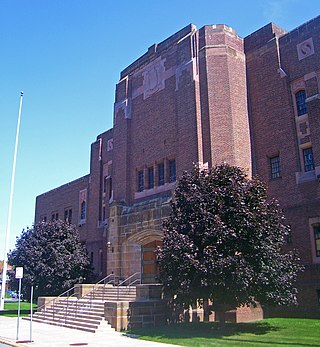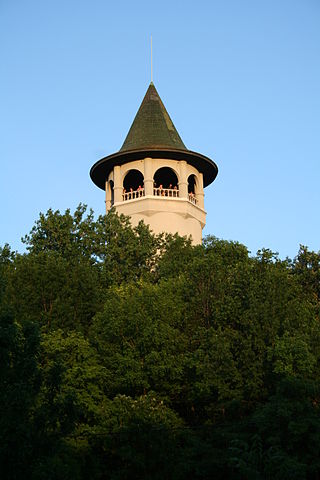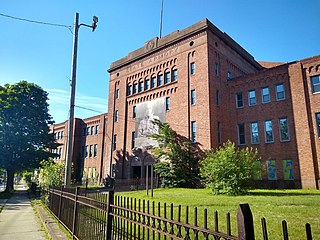
The Minneapolis Armory is a historic event center and former National Guard armory located in downtown Minneapolis, Minnesota, United States. Built by the Public Works Administration in 1936, the building was occupied by several Army and Naval Militia units of the Minnesota National Guard from its opening until 1985. The building is listed on the National Register of Historic Places.

Endion station is a former train station in Duluth, Minnesota, United States. It was built in 1899 to serve the Endion neighborhood but was relocated to Canal Park in 1986 to make way for expansion of Interstate 35. Passenger service through the station had ceased in 1961 and freight service in 1978.

The San Francisco Armory, also known as the San Francisco National Guard Armory and Arsenal or simply The Armory, is a historic building in the Mission District of San Francisco, California. Since 2018, it has been owned by SF Armory LLC, an affiliate of AJ Capital Partners.

The State Armory is a historic armory building at 29 Howard Street in Springfield, Massachusetts. Built in 1895, it is a prominent and distinctive example of Gothic architecture in the city's downtown. The building was the first that was purpose-built for the local militia, and was in its later years home to the South End Community Center. It was listed on the National Register of Historic Places in 1976. It was extensively damaged by the Greater Springfield tornado on June 1, 2011, in which the rear drill shed of the building was reduced to rubble.

This is a list of the National Register of Historic Places listings in Saint Louis County, Minnesota. It is intended to be a complete list of the properties and districts on the National Register of Historic Places in Saint Louis County, Minnesota, United States. The locations of National Register properties and districts for which the latitude and longitude coordinates are included below, may be seen in an online map.

The Flushing Armory is a historic National Guard armory building located in Flushing, Queens. New York City. It is a brick and stone castle-like structure built in 1905–1906, designed to be reminiscent of medieval military structures in Europe. It was designed by state architect George L. Heins.

The Schenectady Armory is located on Washington Avenue in the city of the same name in the U.S. state of New York. It is a brown brick building dating to 1936.

The 369th Regiment Armory is a historic National Guard Armory building located at 2366 Fifth Avenue, between West 142nd and 143rd Streets, in Harlem, Manhattan, New York City. It was built for the 369th Regiment, also known as the "Harlem Hellfighters", founded in 1913 as the first National Guard unit in New York State composed solely of African-Americans. It later became home to the 369th Sustainment Brigade.

The 23rd Regiment Armory, also known as the Bedford Atlantic Armory, is a historic National Guard armory building located at 1322 Bedford Avenue between Atlantic Avenue and Pacific Street in the Crown Heights neighborhood of Brooklyn, New York City, United States. The building is a brick and stone castle-like structure designed to be reminiscent of medieval military structures in Europe. It was built in 1891–95 and was designed in the Romanesque Revival style by Fowler & Hough, local Brooklyn architects, and Isaac Perry, the New York state government's architect.

The 14th Regiment Armory, also known as the Eighth Avenue Armory and the Park Slope Armory, is a historic National Guard armory building located on Eighth Avenue between 14th and 15th Streets in the South Slope neighborhood of Brooklyn, New York City, United States. The building is a brick and stone castle-like structure, and designed to be reminiscent of medieval military structures in Europe. It was built in 1891–95 and was designed in the Late Victorian style by William A. Mundell.

The Lewistown Armory is an historic National Guard armory that is located in Derry Township, Mifflin County, Pennsylvania.

The Lancaster Armory, also known as the Brigadier General Charles P. Stahr Armory, is an historic National Guard armory that is located in Lancaster, Lancaster County, Pennsylvania.

Bethlehem Armory also known as Floyd Simons Armory, is a historic National Guard armory located in Bethlehem in Lehigh County, Pennsylvania. It was built in 1930, and is an "I"-plan brick building in three sections. It consists of a two-story administration building, drill hall, and kitchen / locker room executed in the Art Deco style. It measures 82 by 102 feet, and has a hipped roof. Additions were built in 1938 and 1968.

32nd St. and Lancaster Ave. Philadelphia Armory, also known as the 32nd Street Armory or Drexel Armory, is a historic National Guard armory and multipurpose venue located in the University City neighborhood of Philadelphia, Pennsylvania. Main entrances to the Armory are located at both 33rd and Cuthbert Street, and along Lancaster Walk. Cuthbert Street is part of the Armory property and was removed from Philadelphia city street listing. It was built in 1916, and is a trapezoidal-shaped building in the Classical Revival style. It is a three-story, 21,346 square foot, brick building with stone entablature and parapet. It houses administrative offices, a gymnasium, and drill hall. It was added to the National Register of Historic Places in 1991.

The Prospect Park Water Tower, sometimes referred to as the Witch's Hat Water Tower, is a historic water tower in the Prospect Park neighborhood of Minneapolis, Minnesota, United States. It was built in 1913 on Tower Hill Park, a hilltop park established in 1906. The water tower has become the neighborhood's architectural mascot for its singular design by Frederick William Cappelen. The tower is rumored to be the inspiration for Bob Dylan's song "All Along the Watchtower," as the tower was clearly visible from Dylan's home in nearby Dinkytown.

Fort Collins Armory in Fort Collins, Colorado is a historic armory building designed by local architect Arthur M. Garbutt. It was built in 1907, and it was listed on the National Register of Historic Places in 2002.

The St. Peter Armory is a former National Guard Armory in St. Peter, Minnesota, United States. Built from 1912 to 1913, it is one of the oldest armories still standing in Minnesota and was the first one to be owned by the state upon its completion. It was designed in a restrained Gothic Revival style which captures a transition in Minnesota armory design from heavy, fortresslike buildings to the simpler designs of the 1920s. It was listed on the National Register of Historic Places in 1997 for having local significance in the themes of architecture, military history, and social history. It was nominated for being an excellent example of Minnesota's pre-World War I armories, as well as for its early status, transitional architecture, and role in St. Peter as a center not only of military affairs but also social and recreational events.

The New Haven Armory is a historic building at 270–290 Goffe Street in the Dixwell neighborhood of New Haven, Connecticut, United States. Developed between 1928 and 1930, the armory served the Connecticut National Guard and the Second Company Governor's Foot Guard. It has also served as a venue for concerts, events and other civic functions in the community.

The First Battery Armory, also known as the 102nd Medical Armory and the State Armory, is a historic National Guard armory building at 56 West 66th Street, between Central Park West and Columbus Avenue, on the Upper West Side of Manhattan in New York City, United States. The building was constructed between 1901 and 1904 and was designed by Arthur J. Horgan and Vincent J. Slattery in multiple revival architectural styles. It is composed of a symmetrical brick-and-granite headhouse to the north and a drill hall to the south. The armory is a New York City designated landmark and is listed on the National Register of Historic Places.

The Winona County History Center, located in Winona, Minnesota, is made up of two buildings, the historic Winona Armory and the modern Laird Norton Addition. Established in 1935 by the Winona County Historical Society, the History Center offers collections, exhibits, and programming.






























